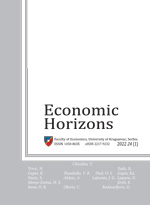
THE JOURNAL IS PUBLISHED
THREE TIMES A YEAR
in April, August and December
Emilija Beker Pucar and Olgica Glavaški
Faculty of Economics in Subotica, University of Novi Sad, Novi Sad, The Republic of Serbia
The paper reviews the monetary stages and frameworks towards the eurozone (EZ) for emerging EU members. At the first pre-EU stage, three monetary frameworks were identified, whereas at the second pre-EZ stage, the emerging EU members combined ER targeting with the rigid/fixed exchange rate regimes (ERRs), on the one hand, and inflation targeting (IT) with the Exchange Rate Mechanism (ERM II), on the other. The last stage of monetary convergence assumes monetary nonautonomy within the monetary union as a rigid ERR, where the ER and monetary policies are sacrificed as countercyclical instruments. Countries with rigid ERRs are more prone to macroeconomic overheating, performing worse under a crisis impact compared to the floaters. The difficulties to maintain stability under a rigid ER environment, such as the monetary union, as well as the inherent vulnerabilities of the EZ, are crucial for the delayed entry of some EU members into the ERM II.
Keywords:
JEL Classification:
Since March 2015, the Journal is indexed in DOAJ
Since November 2013, the Journal is indexed in ProQuest – ABI/INFORM
Since October 2013, the Journal is indexed in Cabell’s Directories
Since September 2013, the Journal is indexed in Index Copernicus Journals Master List 2012
Since March 2013, the Journal has been evaluated and accepted for listing in EconLit (American Economic Association Publications)
Since January 2013, the Journal has been included into EBSCO’s databases
Since November 2012, the Journal has been included into Ulrich’s Periodicals Directory
Since March 2015, the Journal is indexed in DOAJ
Since November 2013, the Journal is indexed in ProQuest – ABI/INFORM
Since October 2013, the Journal is indexed in Cabell’s Directories
Since September 2013, the Journal is indexed in Index Copernicus Journals Master List 2012
Since March 2013, the Journal has been evaluated and accepted for listing in EconLit (American Economic Association Publications)
Since January 2013, the Journal has been included into EBSCO’s databases
Since November 2012, the Journal has been included into Ulrich’s Periodicals Directory